Instrumentation Project: Dark Detector Sensor with LDR Components
VerifiedAdded on 2023/01/05
|27
|4299
|20
Project
AI Summary
This project report details the design and implementation of a dark detector sensor using a Light Dependent Resistor (LDR). The project utilizes components such as BC547 transistors, an LED, a buzzer, resistors, and a 9VDC battery, all connected on a breadboard. The report includes detailed explanations of each component's function, circuit diagrams, schematic diagrams, and the step-by-step procedure for connecting the components. The core concept revolves around the LDR's ability to change its resistance based on light intensity, enabling the circuit to detect darkness. When light is absent, the LDR's resistance increases, triggering the transistors to activate the LED and buzzer. The report also discusses the input measurand (light intensity), sensor input, and the structure and working principle of the LDR, along with its advantages and disadvantages. The project aims to demonstrate the practical application of LDRs in dark detection and automatic switching applications, such as street lights. Furthermore, the report touches upon data acquisition (DAQ) card properties and includes relevant figures and diagrams to illustrate the circuit and its functionality.

Instrumentation 1
INSTRUMENTATION
By Name
Course
Instructor
Institution
Location
Date
INSTRUMENTATION
By Name
Course
Instructor
Institution
Location
Date
Paraphrase This Document
Need a fresh take? Get an instant paraphrase of this document with our AI Paraphraser
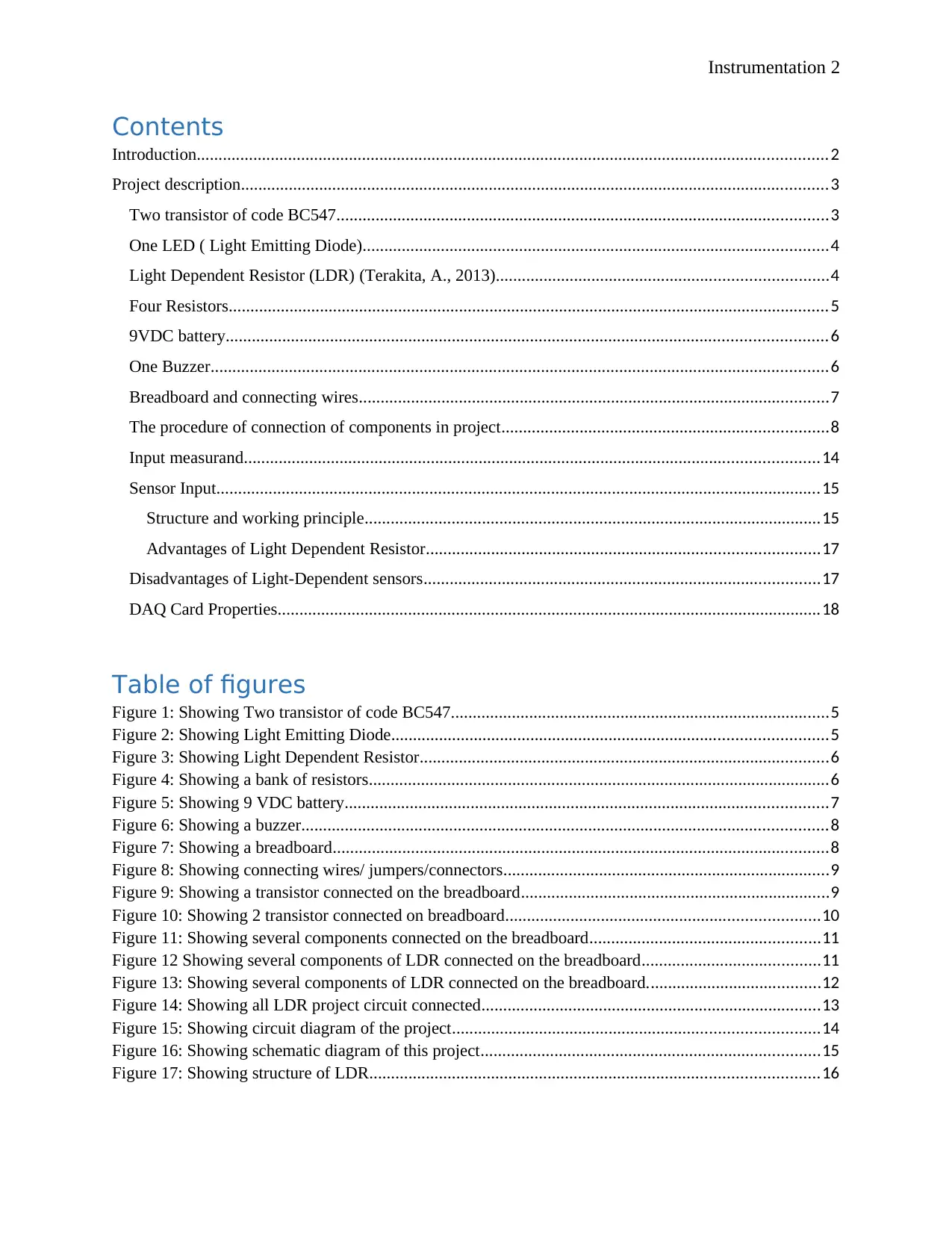
Instrumentation 2
Contents
Introduction.................................................................................................................................................2
Project description.......................................................................................................................................3
Two transistor of code BC547.................................................................................................................3
One LED ( Light Emitting Diode)...........................................................................................................4
Light Dependent Resistor (LDR) (Terakita, A., 2013)............................................................................4
Four Resistors..........................................................................................................................................5
9VDC battery..........................................................................................................................................6
One Buzzer..............................................................................................................................................6
Breadboard and connecting wires............................................................................................................7
The procedure of connection of components in project...........................................................................8
Input measurand....................................................................................................................................14
Sensor Input...........................................................................................................................................15
Structure and working principle.........................................................................................................15
Advantages of Light Dependent Resistor..........................................................................................17
Disadvantages of Light-Dependent sensors...........................................................................................17
DAQ Card Properties.............................................................................................................................18
Table of figures
Figure 1: Showing Two transistor of code BC547.......................................................................................5
Figure 2: Showing Light Emitting Diode....................................................................................................5
Figure 3: Showing Light Dependent Resistor..............................................................................................6
Figure 4: Showing a bank of resistors..........................................................................................................6
Figure 5: Showing 9 VDC battery...............................................................................................................7
Figure 6: Showing a buzzer.........................................................................................................................8
Figure 7: Showing a breadboard..................................................................................................................8
Figure 8: Showing connecting wires/ jumpers/connectors...........................................................................9
Figure 9: Showing a transistor connected on the breadboard.......................................................................9
Figure 10: Showing 2 transistor connected on breadboard........................................................................10
Figure 11: Showing several components connected on the breadboard.....................................................11
Figure 12 Showing several components of LDR connected on the breadboard.........................................11
Figure 13: Showing several components of LDR connected on the breadboard........................................12
Figure 14: Showing all LDR project circuit connected..............................................................................13
Figure 15: Showing circuit diagram of the project....................................................................................14
Figure 16: Showing schematic diagram of this project..............................................................................15
Figure 17: Showing structure of LDR.......................................................................................................16
Contents
Introduction.................................................................................................................................................2
Project description.......................................................................................................................................3
Two transistor of code BC547.................................................................................................................3
One LED ( Light Emitting Diode)...........................................................................................................4
Light Dependent Resistor (LDR) (Terakita, A., 2013)............................................................................4
Four Resistors..........................................................................................................................................5
9VDC battery..........................................................................................................................................6
One Buzzer..............................................................................................................................................6
Breadboard and connecting wires............................................................................................................7
The procedure of connection of components in project...........................................................................8
Input measurand....................................................................................................................................14
Sensor Input...........................................................................................................................................15
Structure and working principle.........................................................................................................15
Advantages of Light Dependent Resistor..........................................................................................17
Disadvantages of Light-Dependent sensors...........................................................................................17
DAQ Card Properties.............................................................................................................................18
Table of figures
Figure 1: Showing Two transistor of code BC547.......................................................................................5
Figure 2: Showing Light Emitting Diode....................................................................................................5
Figure 3: Showing Light Dependent Resistor..............................................................................................6
Figure 4: Showing a bank of resistors..........................................................................................................6
Figure 5: Showing 9 VDC battery...............................................................................................................7
Figure 6: Showing a buzzer.........................................................................................................................8
Figure 7: Showing a breadboard..................................................................................................................8
Figure 8: Showing connecting wires/ jumpers/connectors...........................................................................9
Figure 9: Showing a transistor connected on the breadboard.......................................................................9
Figure 10: Showing 2 transistor connected on breadboard........................................................................10
Figure 11: Showing several components connected on the breadboard.....................................................11
Figure 12 Showing several components of LDR connected on the breadboard.........................................11
Figure 13: Showing several components of LDR connected on the breadboard........................................12
Figure 14: Showing all LDR project circuit connected..............................................................................13
Figure 15: Showing circuit diagram of the project....................................................................................14
Figure 16: Showing schematic diagram of this project..............................................................................15
Figure 17: Showing structure of LDR.......................................................................................................16

Instrumentation 3
Figure 18: Showing a graph illustrating the relationship between electrical resistance and light intensity
.................................................................................................................................................................. 18
Figure 19: Showing block diagram below illustrates the data acquisition card..........................................20
Figure 20: Showing DAQ simulation........................................................................................................21
Figure 21: Showing a flow chart diagram of DAQ....................................................................................22
Figure 22: Showing input circuit of Light-Dependent sensor....................................................................23
Figure 23: Showing the actuator of the light-dependent sensor.................................................................24
Figure 18: Showing a graph illustrating the relationship between electrical resistance and light intensity
.................................................................................................................................................................. 18
Figure 19: Showing block diagram below illustrates the data acquisition card..........................................20
Figure 20: Showing DAQ simulation........................................................................................................21
Figure 21: Showing a flow chart diagram of DAQ....................................................................................22
Figure 22: Showing input circuit of Light-Dependent sensor....................................................................23
Figure 23: Showing the actuator of the light-dependent sensor.................................................................24
⊘ This is a preview!⊘
Do you want full access?
Subscribe today to unlock all pages.

Trusted by 1+ million students worldwide
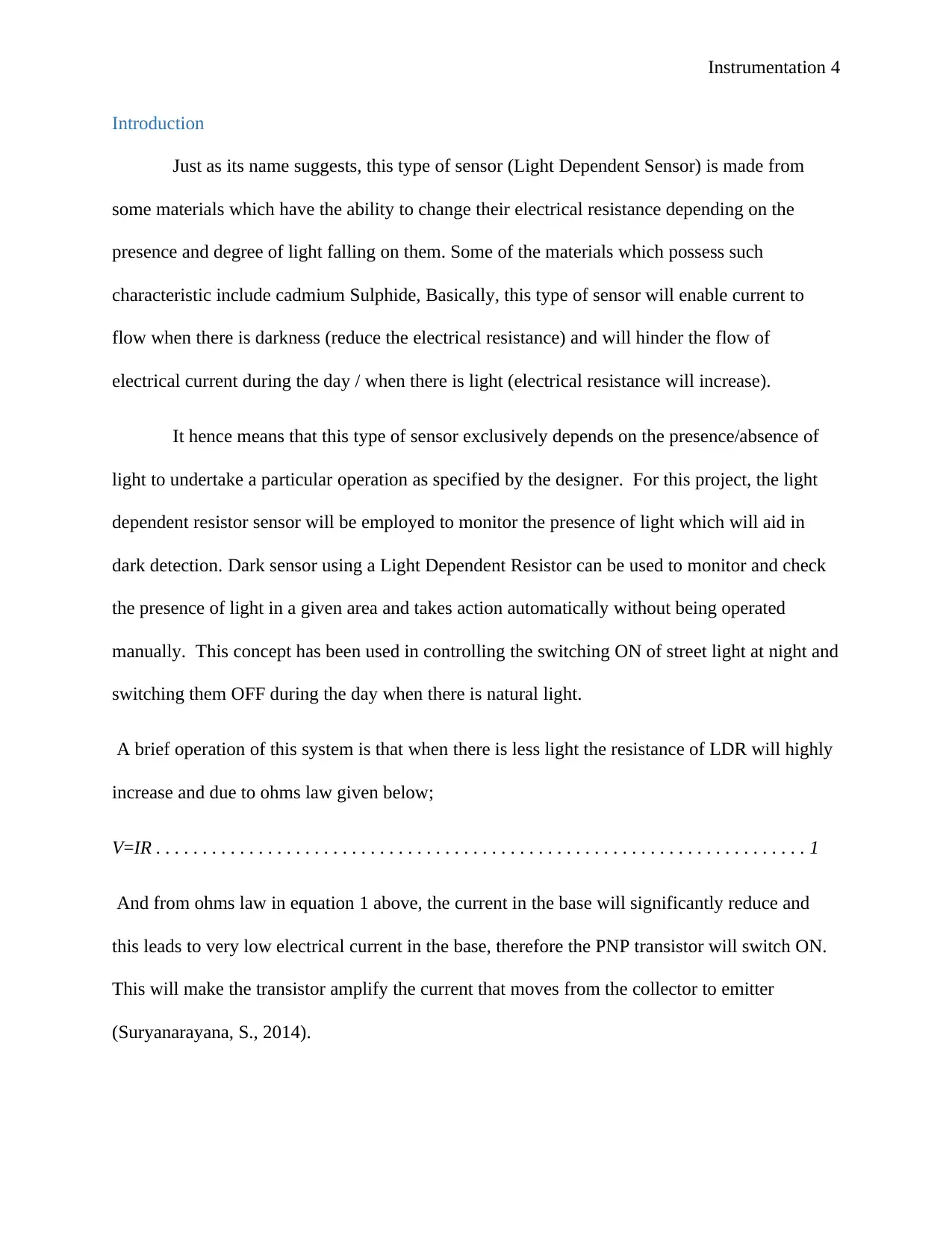
Instrumentation 4
Introduction
Just as its name suggests, this type of sensor (Light Dependent Sensor) is made from
some materials which have the ability to change their electrical resistance depending on the
presence and degree of light falling on them. Some of the materials which possess such
characteristic include cadmium Sulphide, Basically, this type of sensor will enable current to
flow when there is darkness (reduce the electrical resistance) and will hinder the flow of
electrical current during the day / when there is light (electrical resistance will increase).
It hence means that this type of sensor exclusively depends on the presence/absence of
light to undertake a particular operation as specified by the designer. For this project, the light
dependent resistor sensor will be employed to monitor the presence of light which will aid in
dark detection. Dark sensor using a Light Dependent Resistor can be used to monitor and check
the presence of light in a given area and takes action automatically without being operated
manually. This concept has been used in controlling the switching ON of street light at night and
switching them OFF during the day when there is natural light.
A brief operation of this system is that when there is less light the resistance of LDR will highly
increase and due to ohms law given below;
V=IR . . . . . . . . . . . . . . . . . . . . . . . . . . . . . . . . . . . . . . . . . . . . . . . . . . . . . . . . . . . . . . . . . . . . . . 1
And from ohms law in equation 1 above, the current in the base will significantly reduce and
this leads to very low electrical current in the base, therefore the PNP transistor will switch ON.
This will make the transistor amplify the current that moves from the collector to emitter
(Suryanarayana, S., 2014).
Introduction
Just as its name suggests, this type of sensor (Light Dependent Sensor) is made from
some materials which have the ability to change their electrical resistance depending on the
presence and degree of light falling on them. Some of the materials which possess such
characteristic include cadmium Sulphide, Basically, this type of sensor will enable current to
flow when there is darkness (reduce the electrical resistance) and will hinder the flow of
electrical current during the day / when there is light (electrical resistance will increase).
It hence means that this type of sensor exclusively depends on the presence/absence of
light to undertake a particular operation as specified by the designer. For this project, the light
dependent resistor sensor will be employed to monitor the presence of light which will aid in
dark detection. Dark sensor using a Light Dependent Resistor can be used to monitor and check
the presence of light in a given area and takes action automatically without being operated
manually. This concept has been used in controlling the switching ON of street light at night and
switching them OFF during the day when there is natural light.
A brief operation of this system is that when there is less light the resistance of LDR will highly
increase and due to ohms law given below;
V=IR . . . . . . . . . . . . . . . . . . . . . . . . . . . . . . . . . . . . . . . . . . . . . . . . . . . . . . . . . . . . . . . . . . . . . . 1
And from ohms law in equation 1 above, the current in the base will significantly reduce and
this leads to very low electrical current in the base, therefore the PNP transistor will switch ON.
This will make the transistor amplify the current that moves from the collector to emitter
(Suryanarayana, S., 2014).
Paraphrase This Document
Need a fresh take? Get an instant paraphrase of this document with our AI Paraphraser
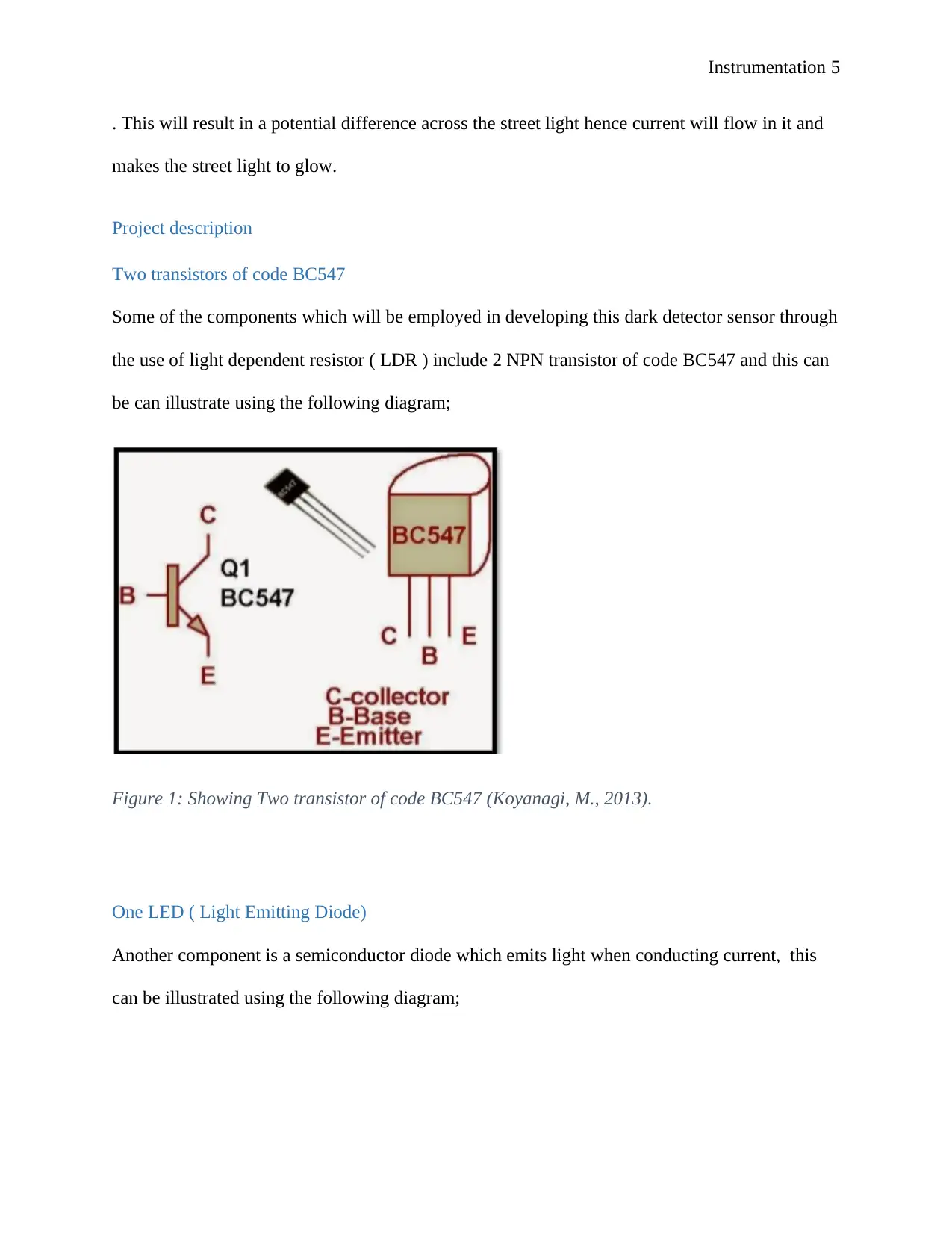
Instrumentation 5
. This will result in a potential difference across the street light hence current will flow in it and
makes the street light to glow.
Project description
Two transistors of code BC547
Some of the components which will be employed in developing this dark detector sensor through
the use of light dependent resistor ( LDR ) include 2 NPN transistor of code BC547 and this can
be can illustrate using the following diagram;
Figure 1: Showing Two transistor of code BC547 (Koyanagi, M., 2013).
One LED ( Light Emitting Diode)
Another component is a semiconductor diode which emits light when conducting current, this
can be illustrated using the following diagram;
. This will result in a potential difference across the street light hence current will flow in it and
makes the street light to glow.
Project description
Two transistors of code BC547
Some of the components which will be employed in developing this dark detector sensor through
the use of light dependent resistor ( LDR ) include 2 NPN transistor of code BC547 and this can
be can illustrate using the following diagram;
Figure 1: Showing Two transistor of code BC547 (Koyanagi, M., 2013).
One LED ( Light Emitting Diode)
Another component is a semiconductor diode which emits light when conducting current, this
can be illustrated using the following diagram;
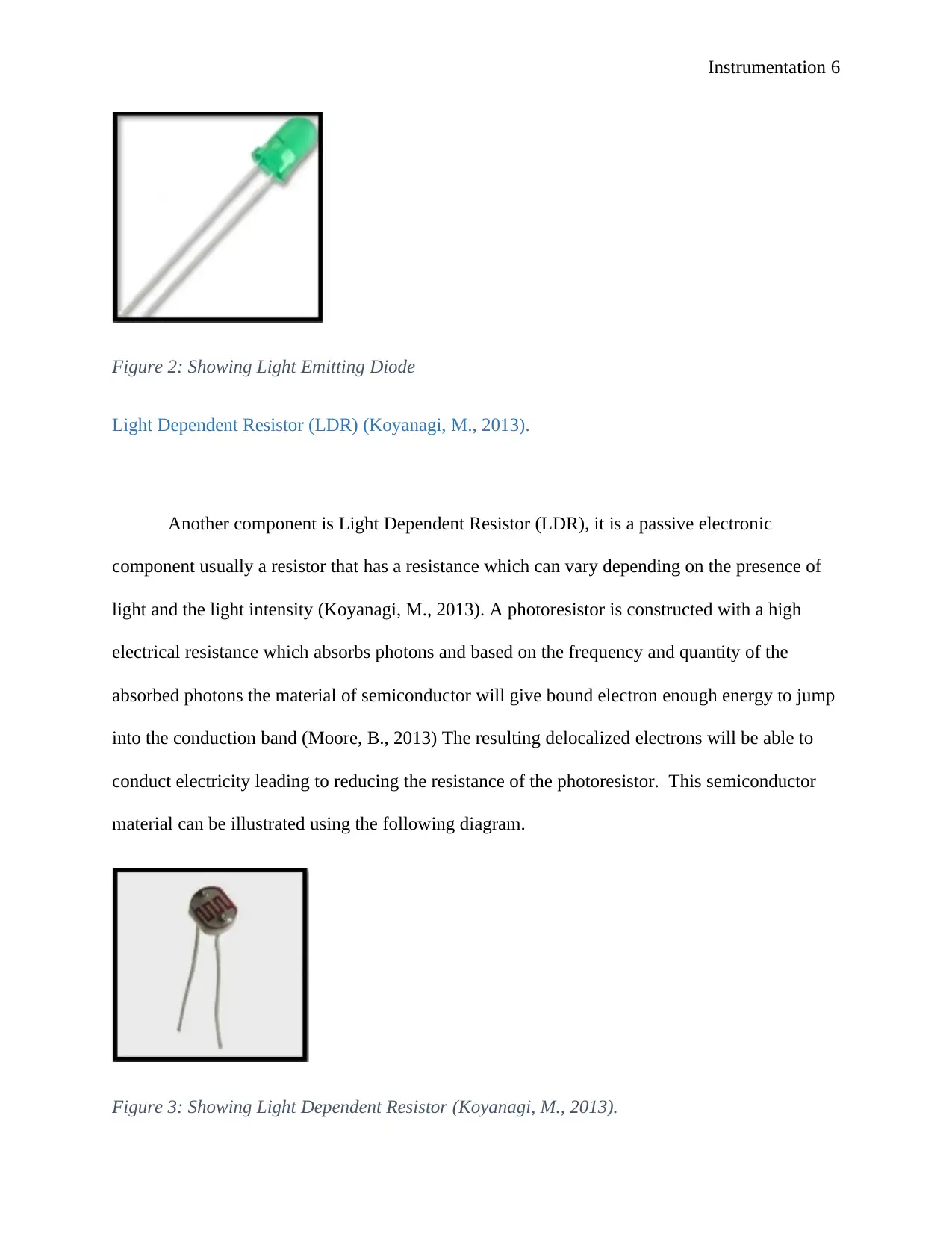
Instrumentation 6
Figure 2: Showing Light Emitting Diode
Light Dependent Resistor (LDR) (Koyanagi, M., 2013).
Another component is Light Dependent Resistor (LDR), it is a passive electronic
component usually a resistor that has a resistance which can vary depending on the presence of
light and the light intensity (Koyanagi, M., 2013). A photoresistor is constructed with a high
electrical resistance which absorbs photons and based on the frequency and quantity of the
absorbed photons the material of semiconductor will give bound electron enough energy to jump
into the conduction band (Moore, B., 2013) The resulting delocalized electrons will be able to
conduct electricity leading to reducing the resistance of the photoresistor. This semiconductor
material can be illustrated using the following diagram.
Figure 3: Showing Light Dependent Resistor (Koyanagi, M., 2013).
Figure 2: Showing Light Emitting Diode
Light Dependent Resistor (LDR) (Koyanagi, M., 2013).
Another component is Light Dependent Resistor (LDR), it is a passive electronic
component usually a resistor that has a resistance which can vary depending on the presence of
light and the light intensity (Koyanagi, M., 2013). A photoresistor is constructed with a high
electrical resistance which absorbs photons and based on the frequency and quantity of the
absorbed photons the material of semiconductor will give bound electron enough energy to jump
into the conduction band (Moore, B., 2013) The resulting delocalized electrons will be able to
conduct electricity leading to reducing the resistance of the photoresistor. This semiconductor
material can be illustrated using the following diagram.
Figure 3: Showing Light Dependent Resistor (Koyanagi, M., 2013).
⊘ This is a preview!⊘
Do you want full access?
Subscribe today to unlock all pages.

Trusted by 1+ million students worldwide
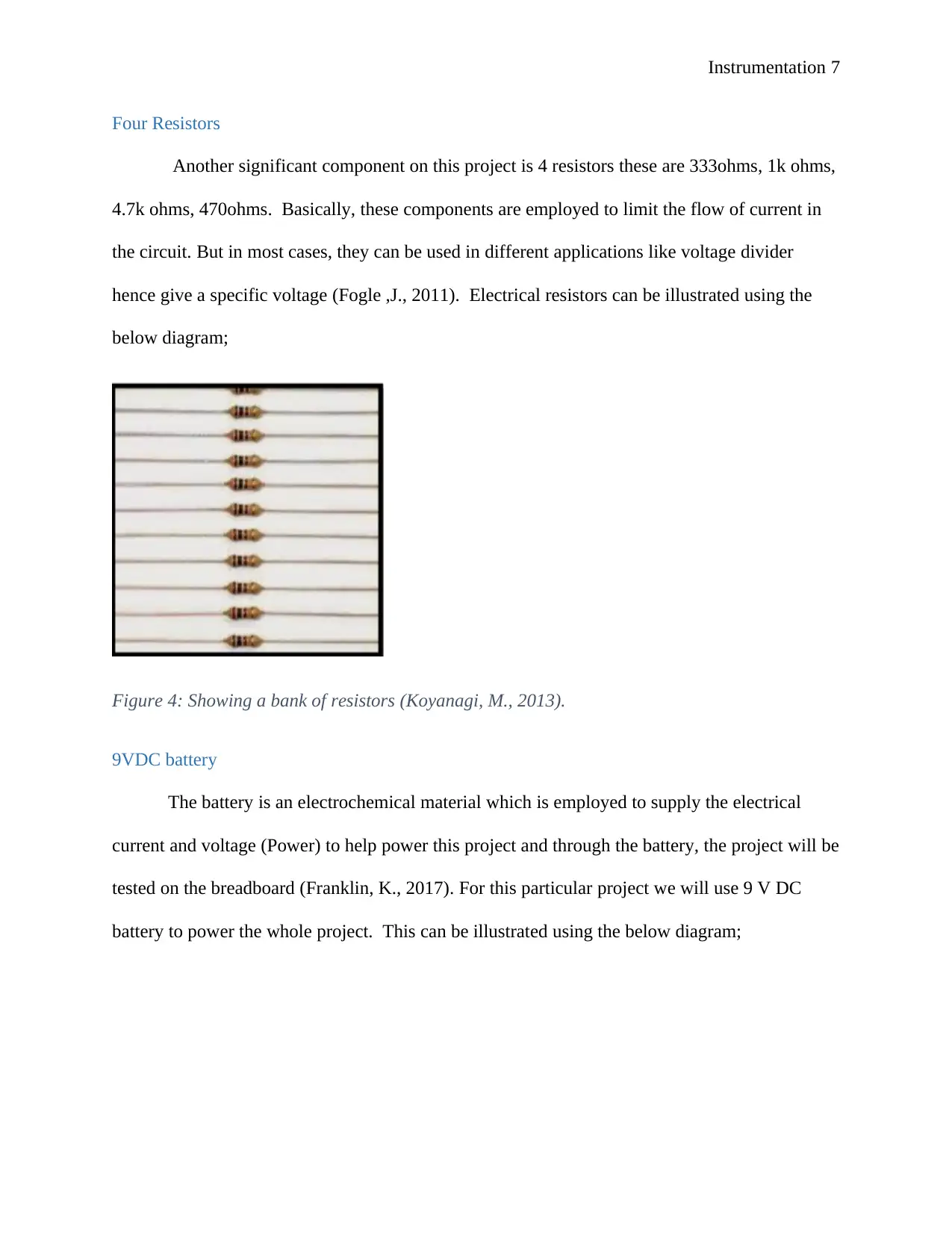
Instrumentation 7
Four Resistors
Another significant component on this project is 4 resistors these are 333ohms, 1k ohms,
4.7k ohms, 470ohms. Basically, these components are employed to limit the flow of current in
the circuit. But in most cases, they can be used in different applications like voltage divider
hence give a specific voltage (Fogle ,J., 2011). Electrical resistors can be illustrated using the
below diagram;
Figure 4: Showing a bank of resistors (Koyanagi, M., 2013).
9VDC battery
The battery is an electrochemical material which is employed to supply the electrical
current and voltage (Power) to help power this project and through the battery, the project will be
tested on the breadboard (Franklin, K., 2017). For this particular project we will use 9 V DC
battery to power the whole project. This can be illustrated using the below diagram;
Four Resistors
Another significant component on this project is 4 resistors these are 333ohms, 1k ohms,
4.7k ohms, 470ohms. Basically, these components are employed to limit the flow of current in
the circuit. But in most cases, they can be used in different applications like voltage divider
hence give a specific voltage (Fogle ,J., 2011). Electrical resistors can be illustrated using the
below diagram;
Figure 4: Showing a bank of resistors (Koyanagi, M., 2013).
9VDC battery
The battery is an electrochemical material which is employed to supply the electrical
current and voltage (Power) to help power this project and through the battery, the project will be
tested on the breadboard (Franklin, K., 2017). For this particular project we will use 9 V DC
battery to power the whole project. This can be illustrated using the below diagram;
Paraphrase This Document
Need a fresh take? Get an instant paraphrase of this document with our AI Paraphraser
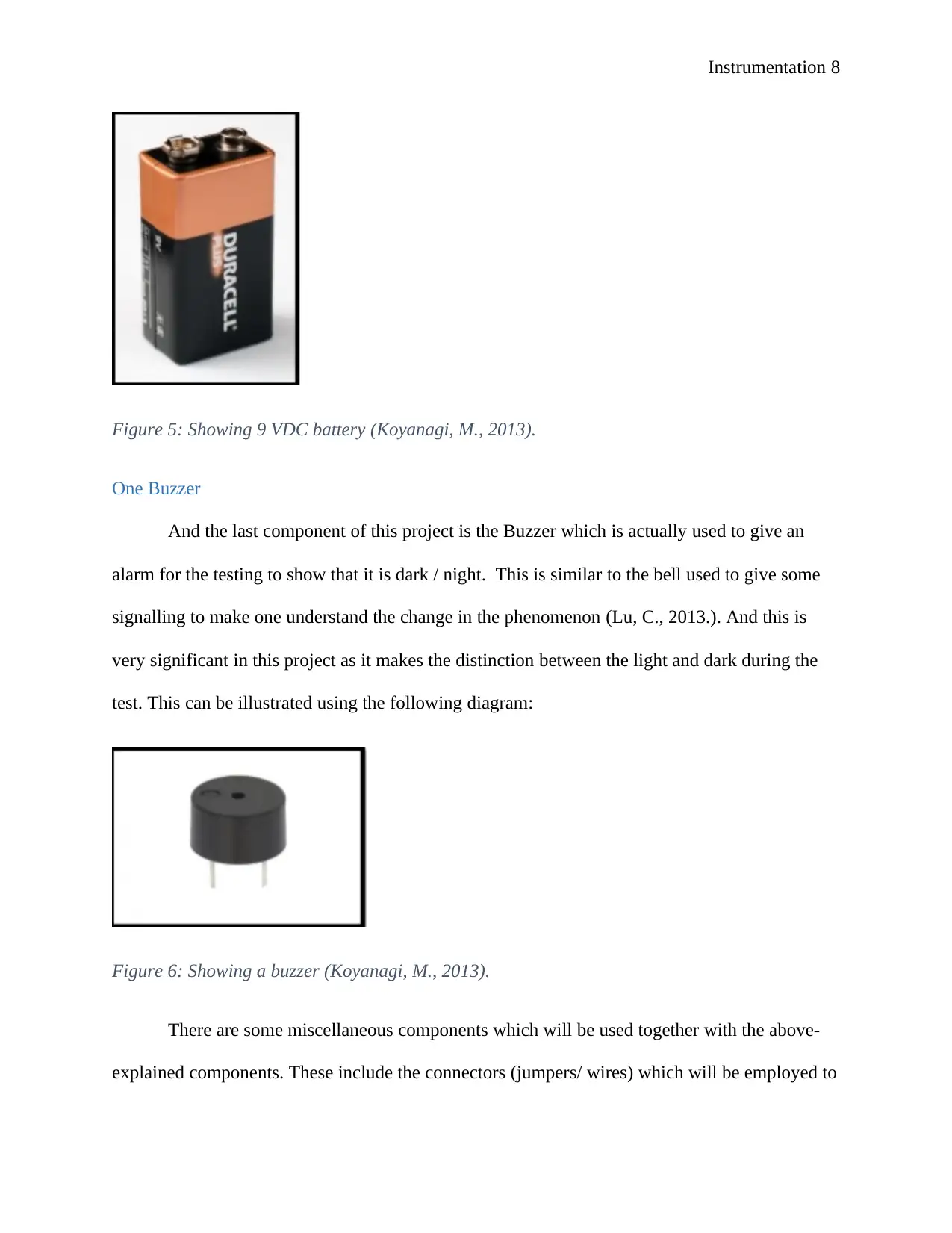
Instrumentation 8
Figure 5: Showing 9 VDC battery (Koyanagi, M., 2013).
One Buzzer
And the last component of this project is the Buzzer which is actually used to give an
alarm for the testing to show that it is dark / night. This is similar to the bell used to give some
signalling to make one understand the change in the phenomenon (Lu, C., 2013.). And this is
very significant in this project as it makes the distinction between the light and dark during the
test. This can be illustrated using the following diagram:
Figure 6: Showing a buzzer (Koyanagi, M., 2013).
There are some miscellaneous components which will be used together with the above-
explained components. These include the connectors (jumpers/ wires) which will be employed to
Figure 5: Showing 9 VDC battery (Koyanagi, M., 2013).
One Buzzer
And the last component of this project is the Buzzer which is actually used to give an
alarm for the testing to show that it is dark / night. This is similar to the bell used to give some
signalling to make one understand the change in the phenomenon (Lu, C., 2013.). And this is
very significant in this project as it makes the distinction between the light and dark during the
test. This can be illustrated using the following diagram:
Figure 6: Showing a buzzer (Koyanagi, M., 2013).
There are some miscellaneous components which will be used together with the above-
explained components. These include the connectors (jumpers/ wires) which will be employed to
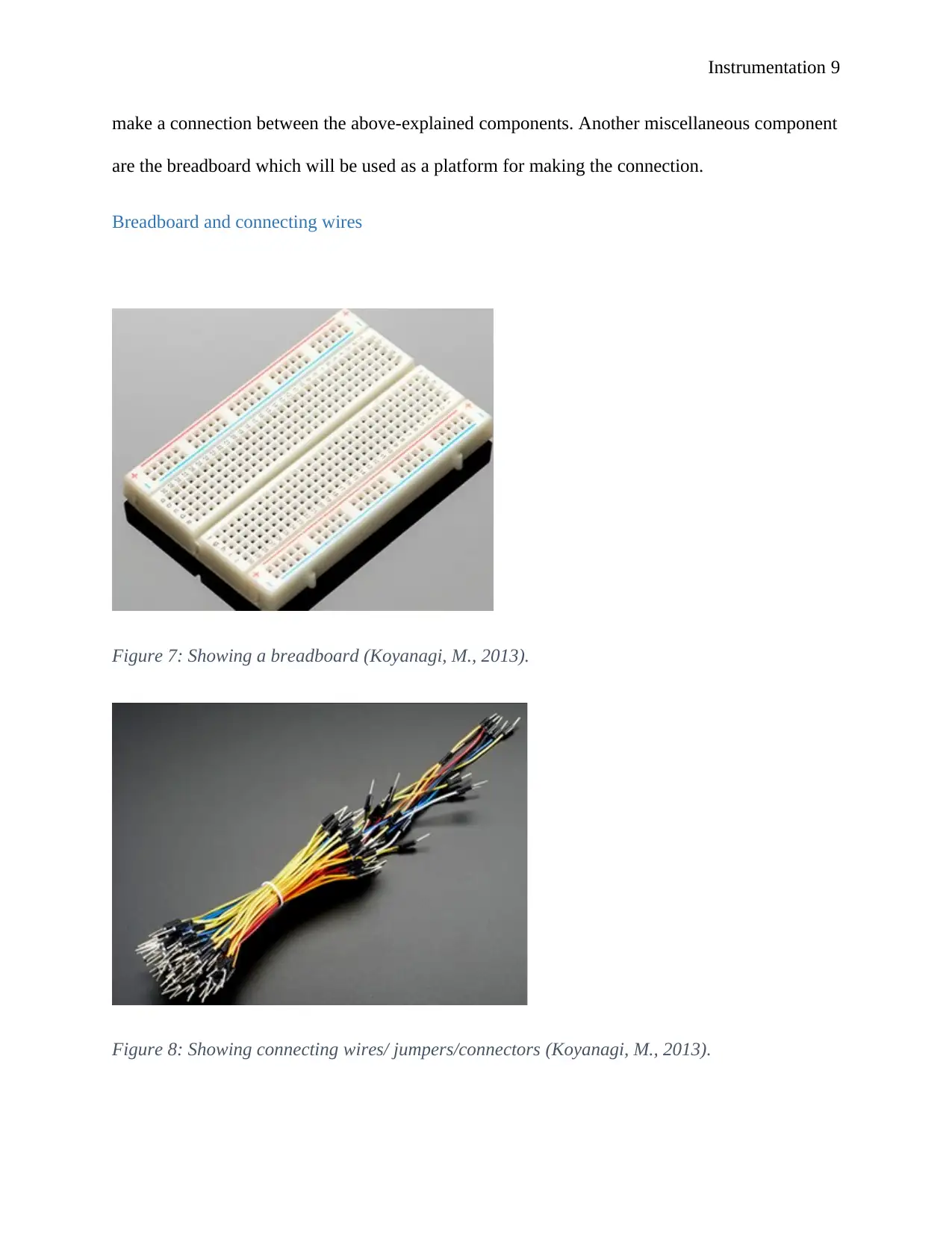
Instrumentation 9
make a connection between the above-explained components. Another miscellaneous component
are the breadboard which will be used as a platform for making the connection.
Breadboard and connecting wires
Figure 7: Showing a breadboard (Koyanagi, M., 2013).
Figure 8: Showing connecting wires/ jumpers/connectors (Koyanagi, M., 2013).
make a connection between the above-explained components. Another miscellaneous component
are the breadboard which will be used as a platform for making the connection.
Breadboard and connecting wires
Figure 7: Showing a breadboard (Koyanagi, M., 2013).
Figure 8: Showing connecting wires/ jumpers/connectors (Koyanagi, M., 2013).
⊘ This is a preview!⊘
Do you want full access?
Subscribe today to unlock all pages.

Trusted by 1+ million students worldwide
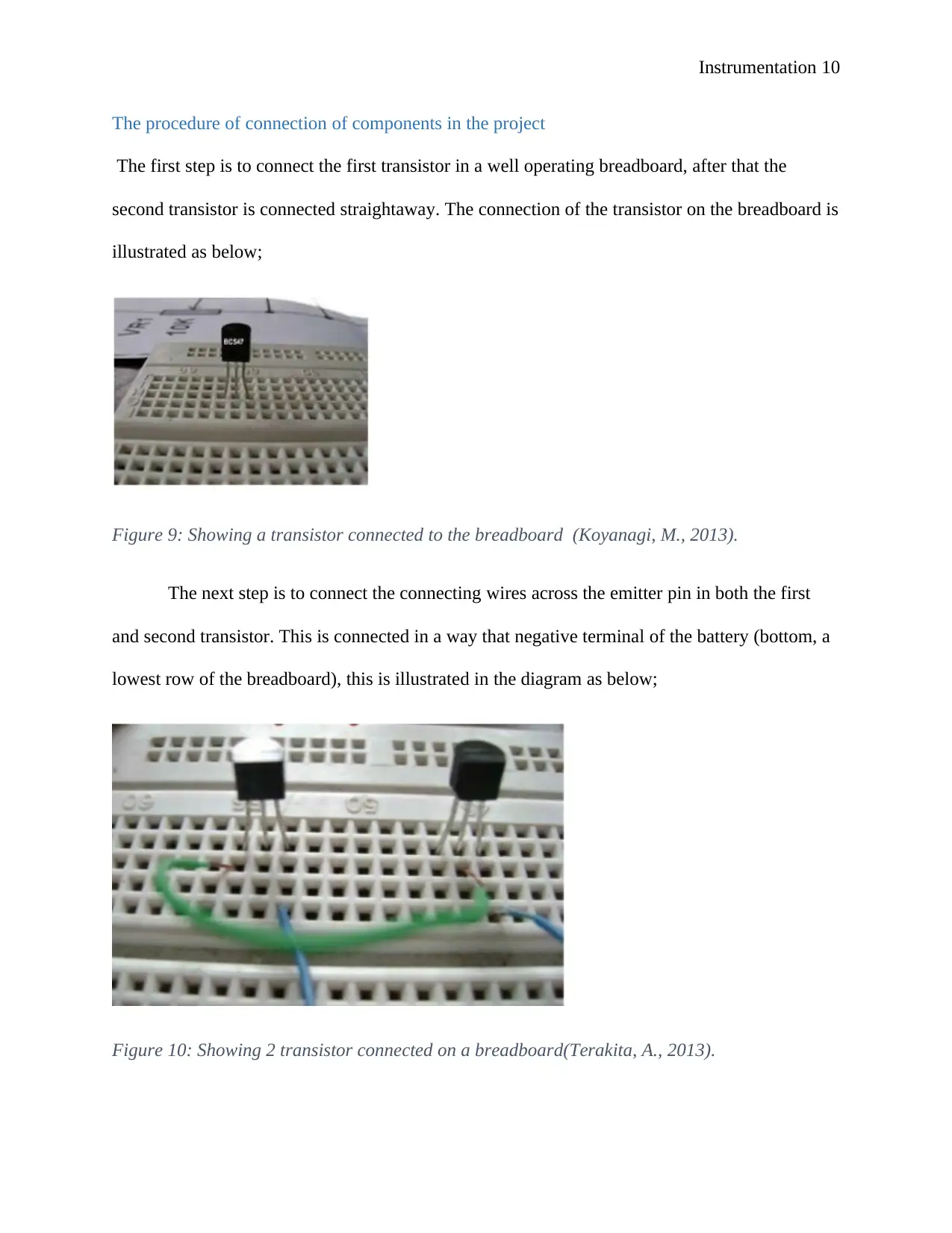
Instrumentation 10
The procedure of connection of components in the project
The first step is to connect the first transistor in a well operating breadboard, after that the
second transistor is connected straightaway. The connection of the transistor on the breadboard is
illustrated as below;
Figure 9: Showing a transistor connected to the breadboard (Koyanagi, M., 2013).
The next step is to connect the connecting wires across the emitter pin in both the first
and second transistor. This is connected in a way that negative terminal of the battery (bottom, a
lowest row of the breadboard), this is illustrated in the diagram as below;
Figure 10: Showing 2 transistor connected on a breadboard(Terakita, A., 2013).
The procedure of connection of components in the project
The first step is to connect the first transistor in a well operating breadboard, after that the
second transistor is connected straightaway. The connection of the transistor on the breadboard is
illustrated as below;
Figure 9: Showing a transistor connected to the breadboard (Koyanagi, M., 2013).
The next step is to connect the connecting wires across the emitter pin in both the first
and second transistor. This is connected in a way that negative terminal of the battery (bottom, a
lowest row of the breadboard), this is illustrated in the diagram as below;
Figure 10: Showing 2 transistor connected on a breadboard(Terakita, A., 2013).
Paraphrase This Document
Need a fresh take? Get an instant paraphrase of this document with our AI Paraphraser
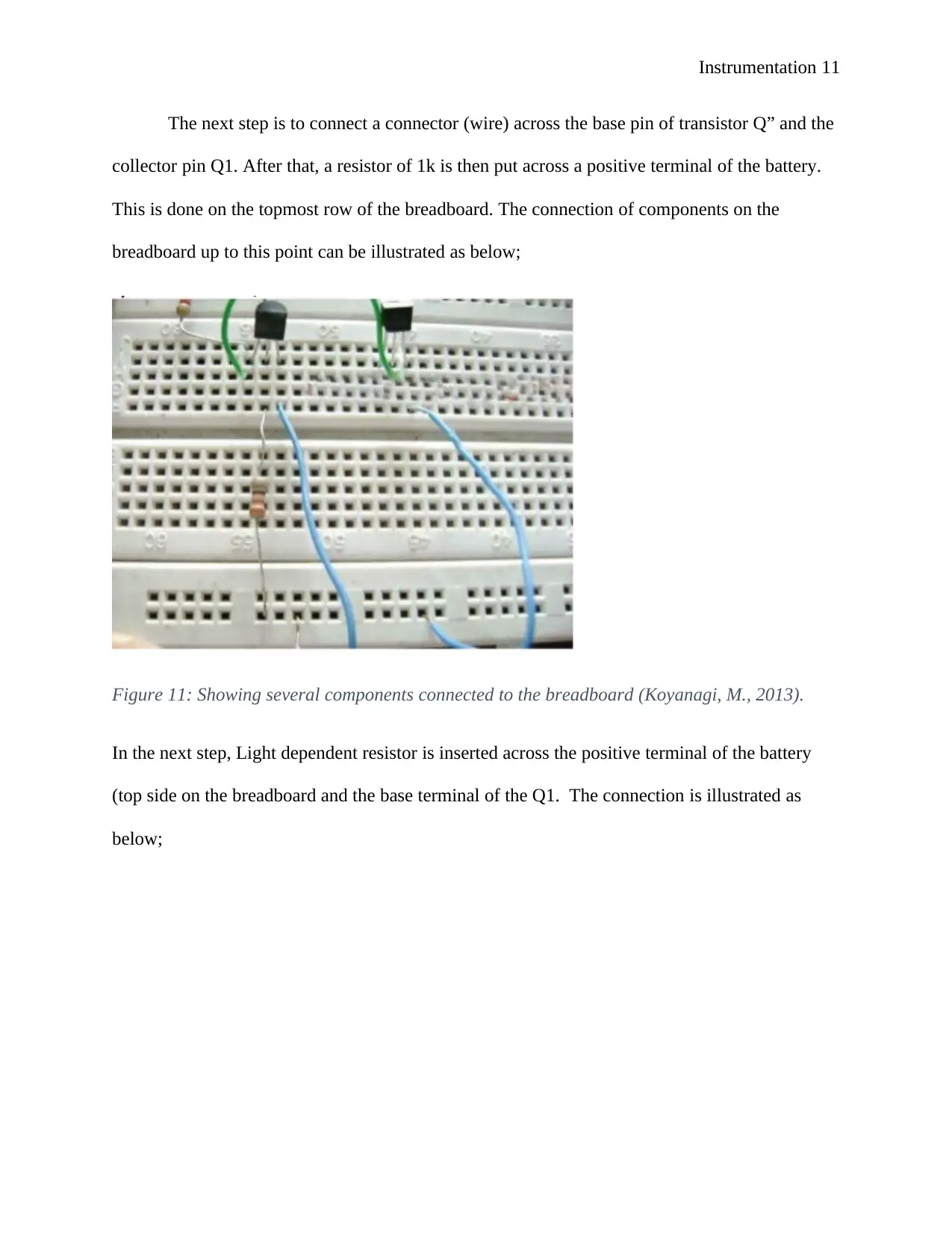
Instrumentation 11
The next step is to connect a connector (wire) across the base pin of transistor Q” and the
collector pin Q1. After that, a resistor of 1k is then put across a positive terminal of the battery.
This is done on the topmost row of the breadboard. The connection of components on the
breadboard up to this point can be illustrated as below;
Figure 11: Showing several components connected to the breadboard (Koyanagi, M., 2013).
In the next step, Light dependent resistor is inserted across the positive terminal of the battery
(top side on the breadboard and the base terminal of the Q1. The connection is illustrated as
below;
The next step is to connect a connector (wire) across the base pin of transistor Q” and the
collector pin Q1. After that, a resistor of 1k is then put across a positive terminal of the battery.
This is done on the topmost row of the breadboard. The connection of components on the
breadboard up to this point can be illustrated as below;
Figure 11: Showing several components connected to the breadboard (Koyanagi, M., 2013).
In the next step, Light dependent resistor is inserted across the positive terminal of the battery
(top side on the breadboard and the base terminal of the Q1. The connection is illustrated as
below;
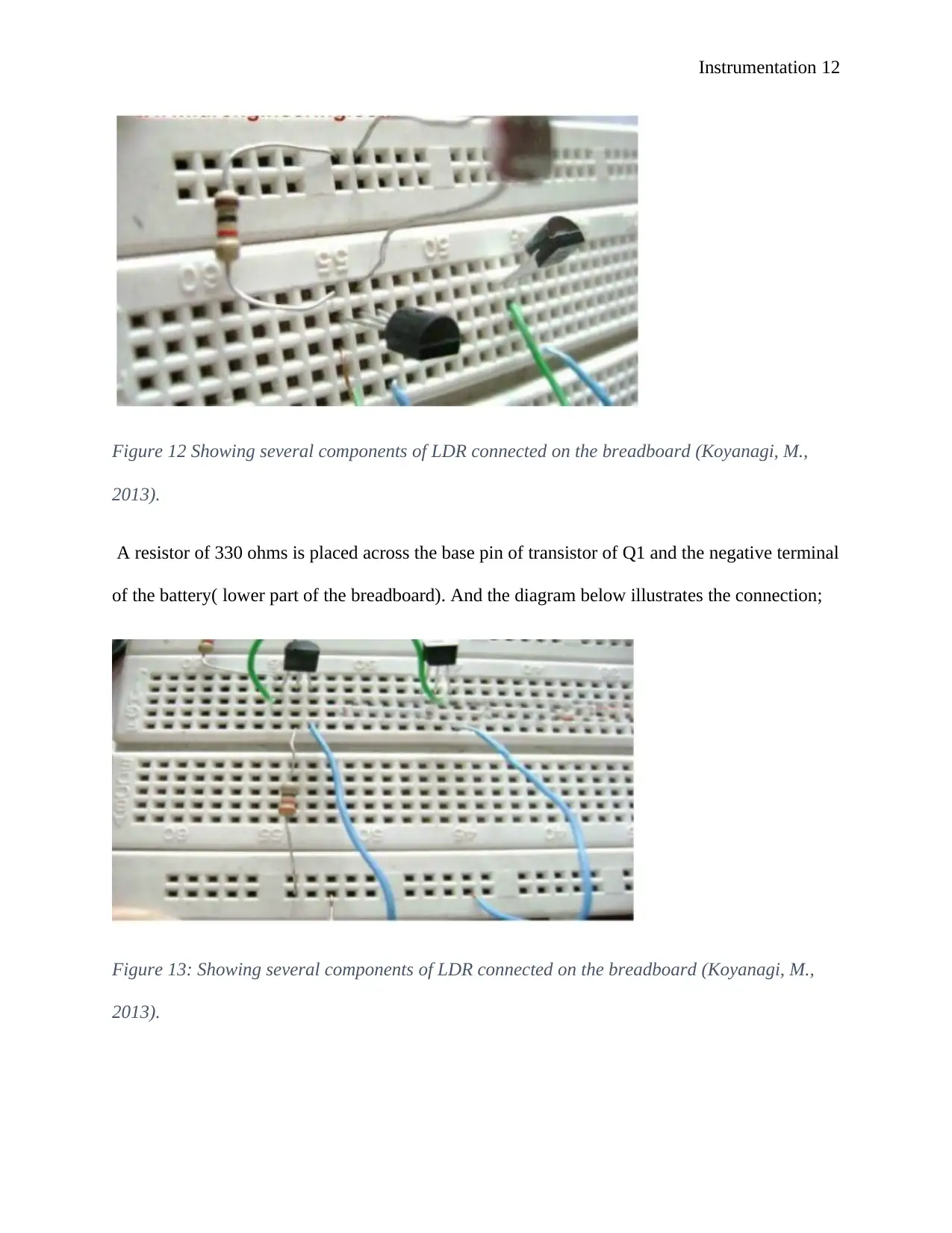
Instrumentation 12
Figure 12 Showing several components of LDR connected on the breadboard (Koyanagi, M.,
2013).
A resistor of 330 ohms is placed across the base pin of transistor of Q1 and the negative terminal
of the battery( lower part of the breadboard). And the diagram below illustrates the connection;
Figure 13: Showing several components of LDR connected on the breadboard (Koyanagi, M.,
2013).
Figure 12 Showing several components of LDR connected on the breadboard (Koyanagi, M.,
2013).
A resistor of 330 ohms is placed across the base pin of transistor of Q1 and the negative terminal
of the battery( lower part of the breadboard). And the diagram below illustrates the connection;
Figure 13: Showing several components of LDR connected on the breadboard (Koyanagi, M.,
2013).
⊘ This is a preview!⊘
Do you want full access?
Subscribe today to unlock all pages.

Trusted by 1+ million students worldwide
1 out of 27
Related Documents
Your All-in-One AI-Powered Toolkit for Academic Success.
+13062052269
info@desklib.com
Available 24*7 on WhatsApp / Email
![[object Object]](/_next/static/media/star-bottom.7253800d.svg)
Unlock your academic potential
Copyright © 2020–2025 A2Z Services. All Rights Reserved. Developed and managed by ZUCOL.




